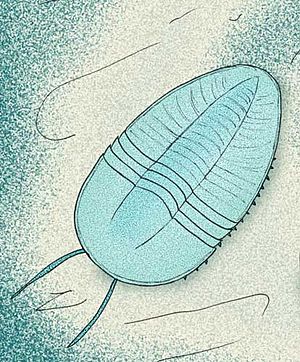Kangacaris facts for kids
Quick facts for kids Kangacaris |
|
|---|---|
 |
|
| Kangacaris zhangi | |
| Scientific classification |
|
| Kingdom: | Animalia |
| Phylum: | Arthropoda |
| Order: | †Nektaspida |
| Family: | †Emucarididae |
| Genus: | †Kangacaris Paterson et al., 2010 |
| Species | |
|
|
Kangacaris is an extinct type of arthropod. It was a creature that lived in the ocean a very long time ago. It looked a bit like a trilobite, which is another ancient sea creature.
Kangacaris lived during the Cambrian period. This was about 517 million years ago! Fossils of K. zhangi have been found in South Australia. Fossils of K. shui have been found in South-West China.
Contents
What's in a Name?
The name Kangacaris comes from two parts. "Kanga" is a short way to say Kangaroo Island. This is where the first fossils were found. The second part, "caris," means "shrimp" in Latin.
The type species, K. zhangi, was named to honor a Chinese scientist. His name is Xingliang Zhang. He is a palaeontologist, which is a scientist who studies fossils.
What Did Kangacaris Look Like?
The top shell of Kangacaris was shaped like an upside-down egg. It was about 3 centimeters (1.2 inches) long. It was also about 2 centimeters (0.8 inches) wide.
Its body had three main parts:
- A semi-circular headshield, called a cephalon.
- A tailshield, called a pygidium.
- Three short body segments in the middle, like a thorax.
A slightly raised line, called the axis, ran down its back. This axis was about one-third the width of its body. The tailshield had a border with about 17 small ridges. These ridges went straight out from the edge.
K. shui had a slightly different look than K. zhangi. Its axis was clearer and narrower. Its headshield had a more curved back edge. Also, its tailshield was smaller.
How Kangacaris Was Different from Emucaris
Kangacaris was similar to another ancient creature called Emucaris fava. But there were some key differences.
- Kangacaris had three body segments in its middle section. Emucaris had four.
- The main body of Kangacaris was shaped like an upside-down egg. The tailshield of Emucaris was more like a triangle.
- The axis on Kangacaris tailshield was one-third of its body width. It also had clear segments. The axis on Emucaris tailshield was only one-fifth of its body width. It had a pattern of small shapes instead of clear segments.
- Emucaris had a small spine at the end of its tailshield. Kangacaris did not have this spine.
Where Were Kangacaris Fossils Found?
Fossils of K. zhangi were found in a place called the Emu Bay Shale. This area is on Kangaroo Island in South Australia.
Fossils of K. shui were discovered in the Maotianshan Shales. This location is in Yunnan, which is in South-West China.

